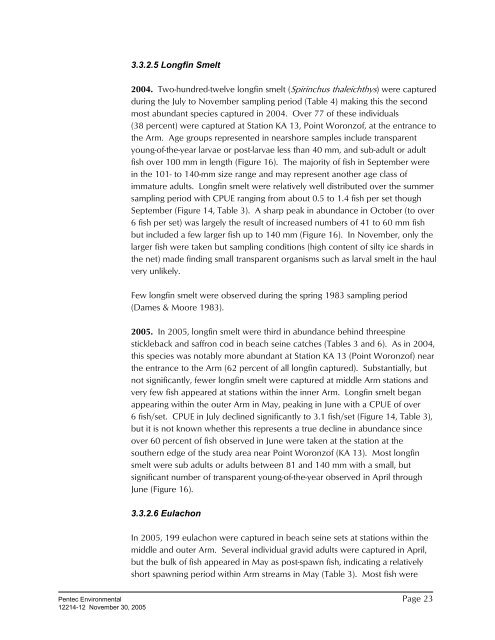Marine Fish and Benthos Studies - Knik Arm Bridge and Toll Authority
Marine Fish and Benthos Studies - Knik Arm Bridge and Toll Authority
Marine Fish and Benthos Studies - Knik Arm Bridge and Toll Authority
You also want an ePaper? Increase the reach of your titles
YUMPU automatically turns print PDFs into web optimized ePapers that Google loves.
3.3.2.5 Longfin Smelt<br />
2004. Two-hundred-twelve longfin smelt (Spirinchus thaleichthys) were captured<br />
during the July to November sampling period (Table 4) making this the second<br />
most abundant species captured in 2004. Over 77 of these individuals<br />
(38 percent) were captured at Station KA 13, Point Woronzof, at the entrance to<br />
the <strong>Arm</strong>. Age groups represented in nearshore samples include transparent<br />
young-of-the-year larvae or post-larvae less than 40 mm, <strong>and</strong> sub-adult or adult<br />
fish over 100 mm in length (Figure 16). The majority of fish in September were<br />
in the 101- to 140-mm size range <strong>and</strong> may represent another age class of<br />
immature adults. Longfin smelt were relatively well distributed over the summer<br />
sampling period with CPUE ranging from about 0.5 to 1.4 fish per set though<br />
September (Figure 14, Table 3). A sharp peak in abundance in October (to over<br />
6 fish per set) was largely the result of increased numbers of 41 to 60 mm fish<br />
but included a few larger fish up to 140 mm (Figure 16). In November, only the<br />
larger fish were taken but sampling conditions (high content of silty ice shards in<br />
the net) made finding small transparent organisms such as larval smelt in the haul<br />
very unlikely.<br />
Few longfin smelt were observed during the spring 1983 sampling period<br />
(Dames & Moore 1983).<br />
2005. In 2005, longfin smelt were third in abundance behind threespine<br />
stickleback <strong>and</strong> saffron cod in beach seine catches (Tables 3 <strong>and</strong> 6). As in 2004,<br />
this species was notably more abundant at Station KA 13 (Point Woronzof) near<br />
the entrance to the <strong>Arm</strong> (62 percent of all longfin captured). Substantially, but<br />
not significantly, fewer longfin smelt were captured at middle <strong>Arm</strong> stations <strong>and</strong><br />
very few fish appeared at stations within the inner <strong>Arm</strong>. Longfin smelt began<br />
appearing within the outer <strong>Arm</strong> in May, peaking in June with a CPUE of over<br />
6 fish/set. CPUE in July declined significantly to 3.1 fish/set (Figure 14, Table 3),<br />
but it is not known whether this represents a true decline in abundance since<br />
over 60 percent of fish observed in June were taken at the station at the<br />
southern edge of the study area near Point Woronzof (KA 13). Most longfin<br />
smelt were sub adults or adults between 81 <strong>and</strong> 140 mm with a small, but<br />
significant number of transparent young-of-the-year observed in April through<br />
June (Figure 16).<br />
3.3.2.6 Eulachon<br />
In 2005, 199 eulachon were captured in beach seine sets at stations within the<br />
middle <strong>and</strong> outer <strong>Arm</strong>. Several individual gravid adults were captured in April,<br />
but the bulk of fish appeared in May as post-spawn fish, indicating a relatively<br />
short spawning period within <strong>Arm</strong> streams in May (Table 3). Most fish were<br />
Pentec Environmental Page 23<br />
12214-12 November 30, 2005
















